We left the mystery and awe of the Mekong Delta and landed in the modern city of Da Nang. As Vietnam’s fifth largest city, Da Nang is a busy place. It’s also known as Vietnam’s third city, because it’s more of an urban metropolis, like Ho Chi Minh City and Hanoi, but isn’t quite as big population-wise. But, what makes Da Nang quite different from other Vietnamese cities is that much of its growth has been in the last decade, so it feels really modern. It’s no wonder it’s considered the most livable city in Vietnam.
Our hotel was absolutely amazing and I couldn’t recommend it enough. We stayed at SHI HOUSE by Haviland. It was cool, modern and super functional. Haviland is a furniture design company, so all the furniture in the hotel room is for sale! I loved the feel of it and instantly regretted not having more time here.
 Nonetheless, we immediately made the most of our visit to Da Nang by exploring a not-so-modern-looking attraction: Chùa Linh Ứng (Linh Ung Pagoda). There are actually three pagodas with the same name in Da Nang, but this one is situated on Son Tra Peninsula. It faces the beachfront of Da Nang, overlooking the East Sea. The mountain behind the pagoda is known as Monkey Mountain. A U.S. military communications facility was located here during the Vietnam War and the soldiers encountered monkeys often, nicknamed the mountain as such.
Nonetheless, we immediately made the most of our visit to Da Nang by exploring a not-so-modern-looking attraction: Chùa Linh Ứng (Linh Ung Pagoda). There are actually three pagodas with the same name in Da Nang, but this one is situated on Son Tra Peninsula. It faces the beachfront of Da Nang, overlooking the East Sea. The mountain behind the pagoda is known as Monkey Mountain. A U.S. military communications facility was located here during the Vietnam War and the soldiers encountered monkeys often, nicknamed the mountain as such.
The pagoda is within a complex covering 20 hectares, in which there is a main hall, ancestor’s house, lecture hall, library, cafeteria and Arhat statue garden.


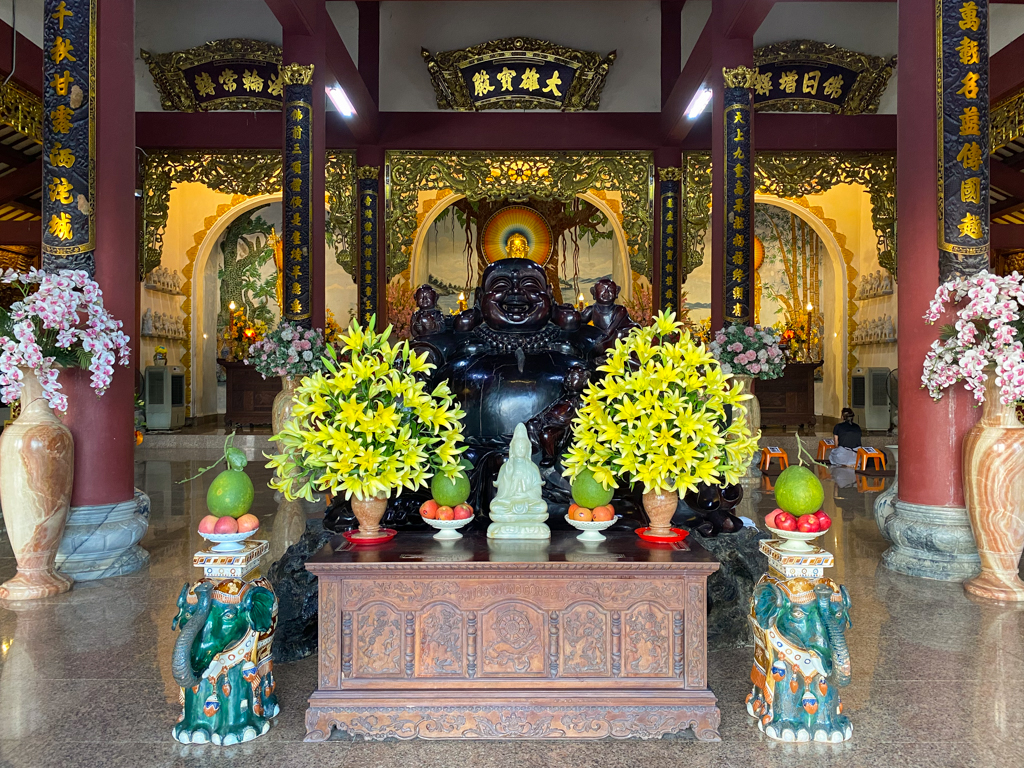
My favourite part of the complex is the beautiful bonsai tree display garden. Bonsai trees represent the perfect balance between nature and art, representing how people can attain peace within themselves. We traveled throughout Vietnam for 3.5 weeks and I never saw a more impressive collection. These were simply just spectacular.

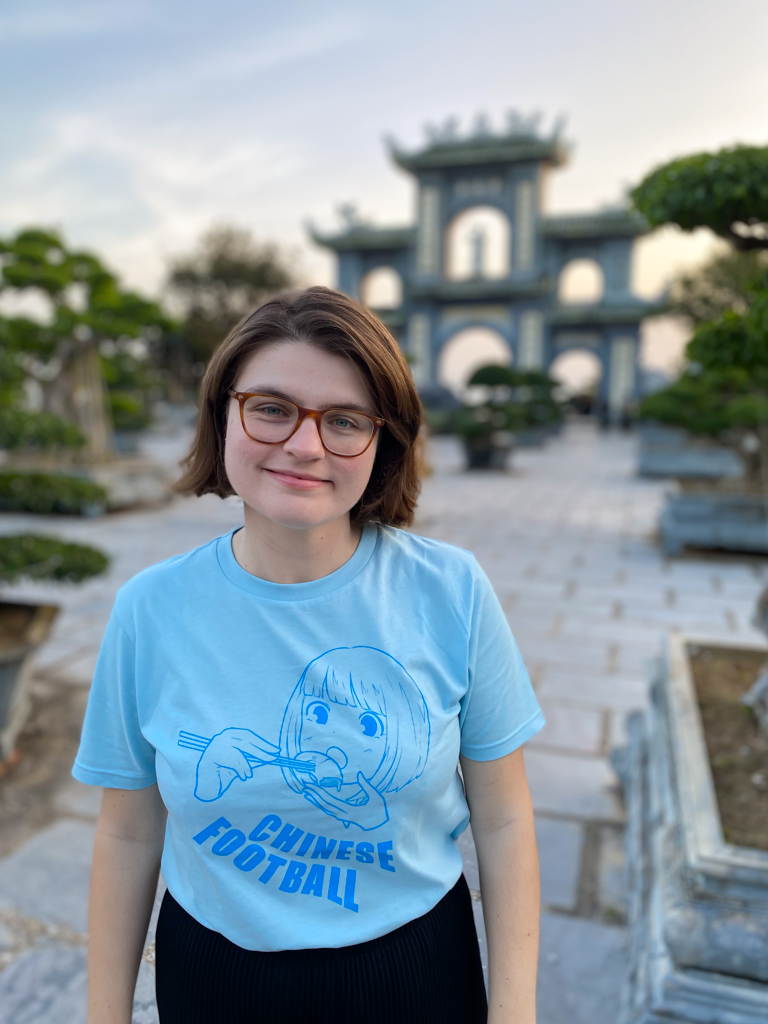

The most prominent feature of the Linh Ung Pagoda is the Lady Buddha statue, the tallest one in Vietnam with a height of 67 meters. Lady Buddha is a symbol of peace, joy and prosperity. The statue represents Avalokitesvara or Guanyin, a female bodhisattva from Buddhist mythology believed to help all living beings with compassion and mercy. So, sometimes she’s known as the Goddess of Mercy.


The complex became particularly magical once the sun started to set. The lights started to turn on, and the monuments were lit up in a way that transformed the feeling of the whole place.

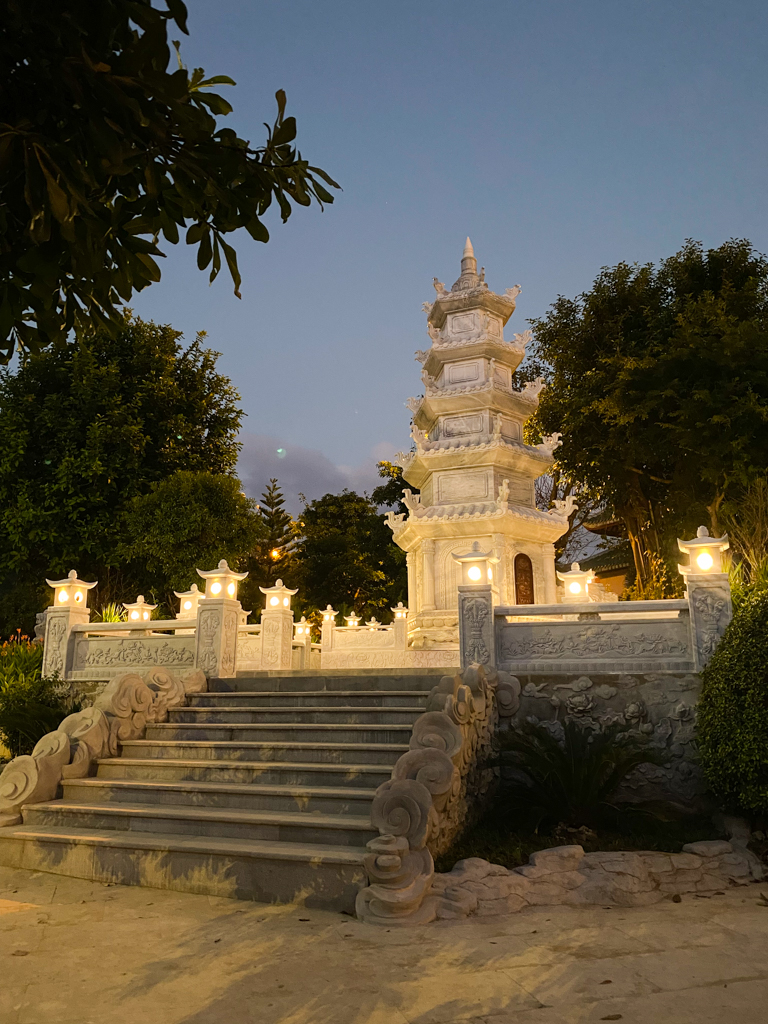
Even the Lady Buddha looked particularly spectacular! We discovered pretty early on in our trip that Vietnamese decorations are often well-lit and rainbow-coloured. The Lady Buddha was no exception.
 Once the sun had set completely and it was proper nighttime, we grabbed a Grab (I see where the name comes from now) to walk along the Hàn River downtown. We walked from the Song Han Bridge to the Dragon Bridge, which is only about a 15-minute walk. The walkway along the river is very nice, as you can see the entire skyline.
Once the sun had set completely and it was proper nighttime, we grabbed a Grab (I see where the name comes from now) to walk along the Hàn River downtown. We walked from the Song Han Bridge to the Dragon Bridge, which is only about a 15-minute walk. The walkway along the river is very nice, as you can see the entire skyline.
You also can spot the Dragon Bridge from afar pretty quickly. It’s the world’s largest dragon-shaped steel bridge. With an installation cost of $85 million, it has 6 lanes and 666 meters of undulating steel shaped into a Ly-Dynasty dragon figure, the symbol of prosperity in Vietnamese culture.
 By chance, we were in Da Nang on a Friday night, and so the Dragon Bridge “breathes” fire and water. Every Friday, Saturday, Sunday and major holidays such as Vietnamese Tet, the Dragon Bridge fire show takes place at 9:00pm. The dragon first bursts with flames shooting in the air, followed by sprays of water. If you look into this elsewhere online, you’ll read stories about people getting completely soaked, depending on where they’re standing!
By chance, we were in Da Nang on a Friday night, and so the Dragon Bridge “breathes” fire and water. Every Friday, Saturday, Sunday and major holidays such as Vietnamese Tet, the Dragon Bridge fire show takes place at 9:00pm. The dragon first bursts with flames shooting in the air, followed by sprays of water. If you look into this elsewhere online, you’ll read stories about people getting completely soaked, depending on where they’re standing!
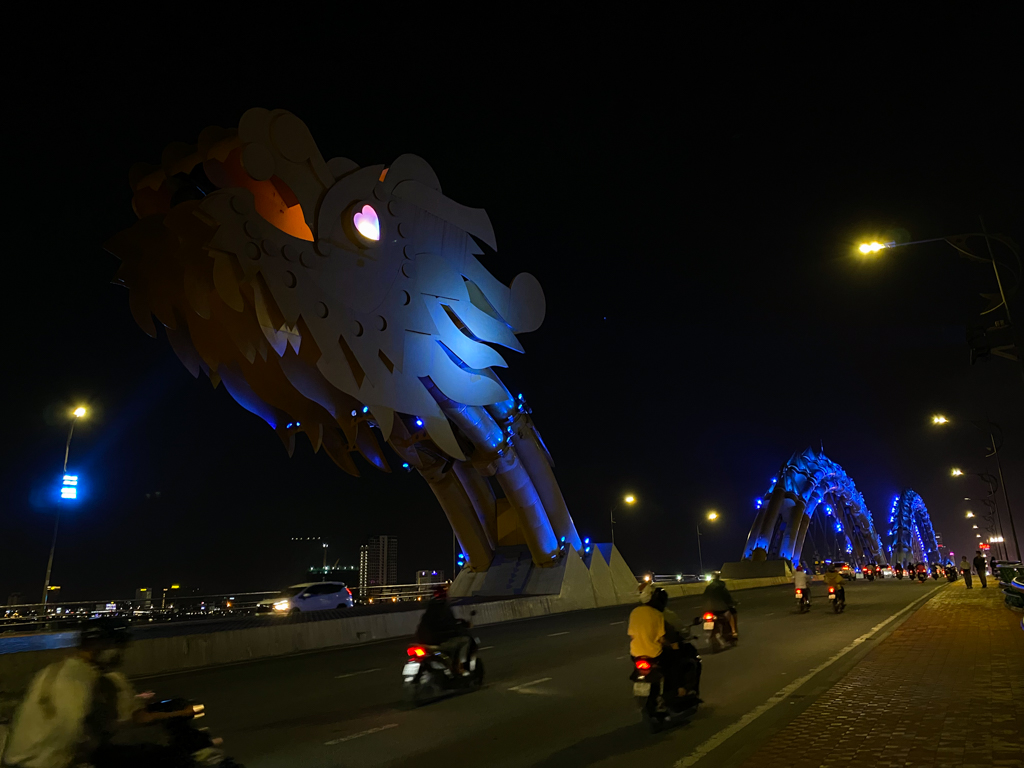
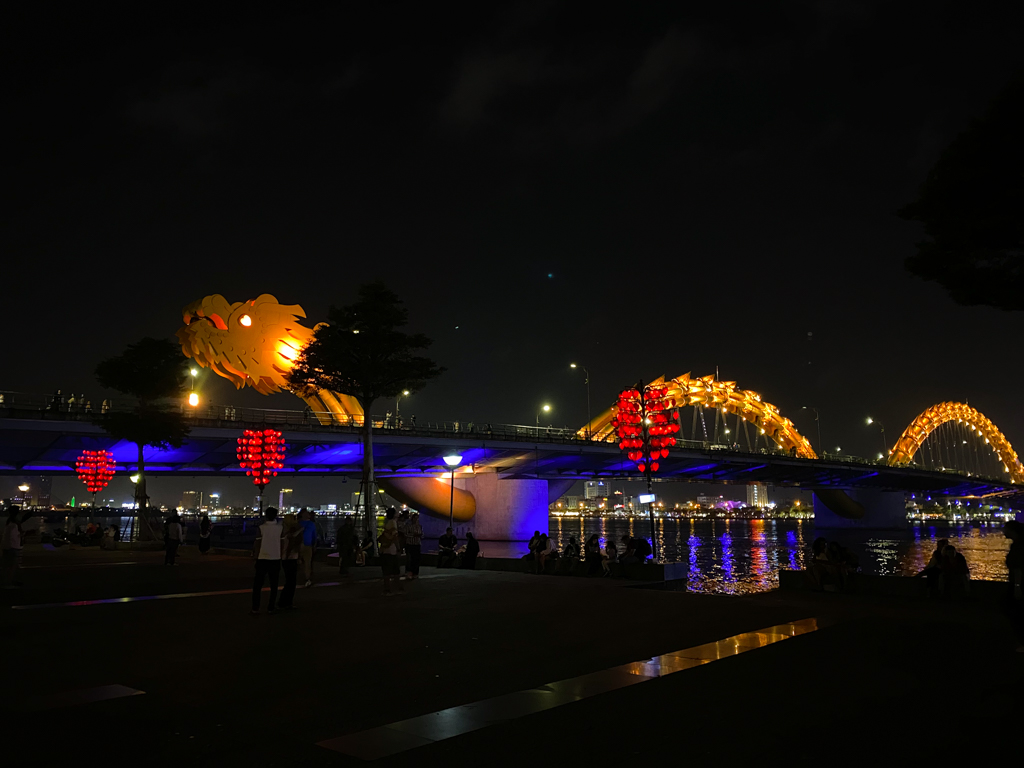 For dinner, we stopped by the Son Tra Night Market. I thought I was prepared for the chaos because I had visited numerous night markets in Thailand, but I was not prepared for the onslaught of sellers and their constant yelling. I couldn’t even take one step without a young lady forcing a menu into my face!
For dinner, we stopped by the Son Tra Night Market. I thought I was prepared for the chaos because I had visited numerous night markets in Thailand, but I was not prepared for the onslaught of sellers and their constant yelling. I couldn’t even take one step without a young lady forcing a menu into my face!
Eventually, I started to get used to the chaotic environment and finally was able to pick a stall that I liked. We went to a grill where we got freshly grilled squid, octopus and pork belly. We also got bánh khọt from another stall. Bánh khọt are mini savoury pancakes with a whole piece of shrimp (shell and all) in the middle. They’re oily, that’s for sure, but also incredibly crispy and juicy. They’re a really fun street snack! Afterwards, we went back to our hotel for the night.
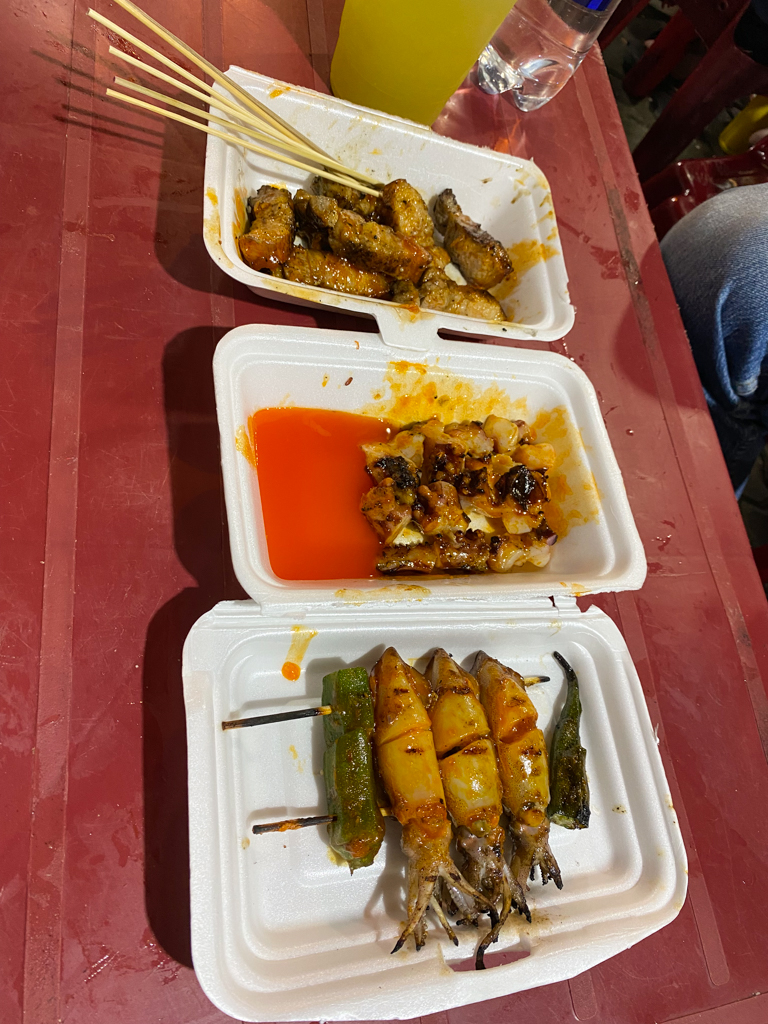
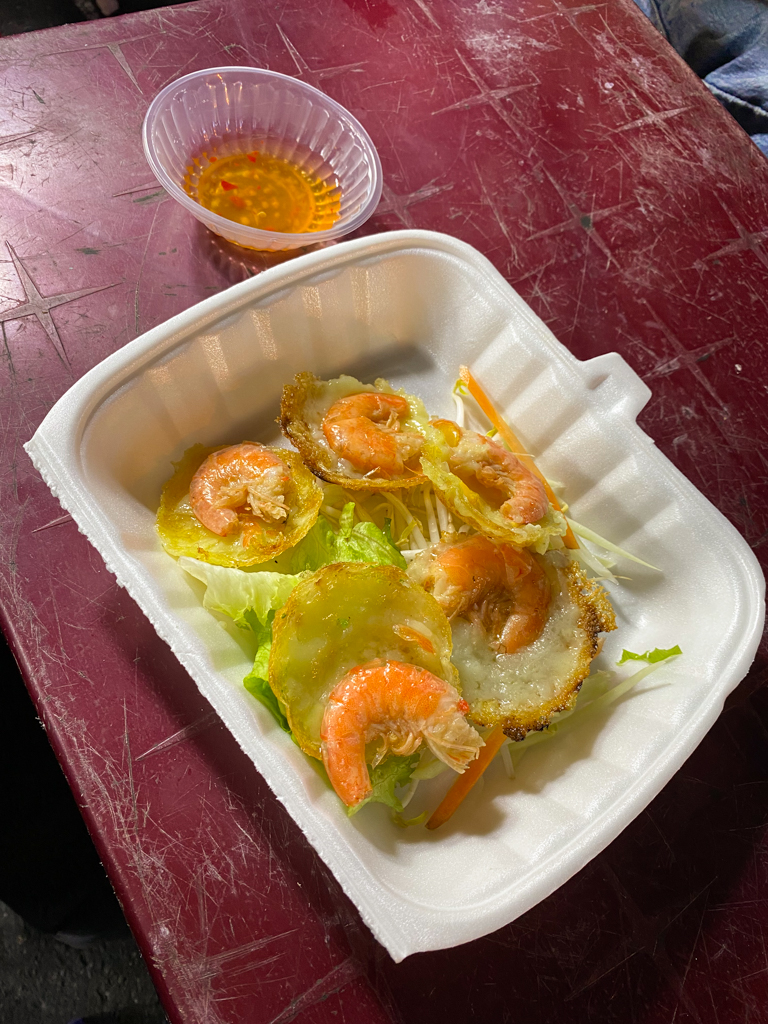
The next morning we headed out early for breakfast at Mì Quảng Dung. It’s a local noodle shop that serves mì quảng, a dish made with flat yellow rice noodles, served in an intensely flavoured broth with a medley of fresh herbs and vegetables. Toppings vary, but we ordered ours with turmeric fish. Delicious!
It’s very typical to have bánh tráng mè, also known as bánh đa, with mì quảng. They are thin, crispy sheets made from tapioca or rice flour mixed with black sesame seeds. When toasted over an open flame or in the microwave, they puff up into light and crunchy crackers, which can be eaten as a snack or used as a topping for mì quảng and other Vietnamese dishes.
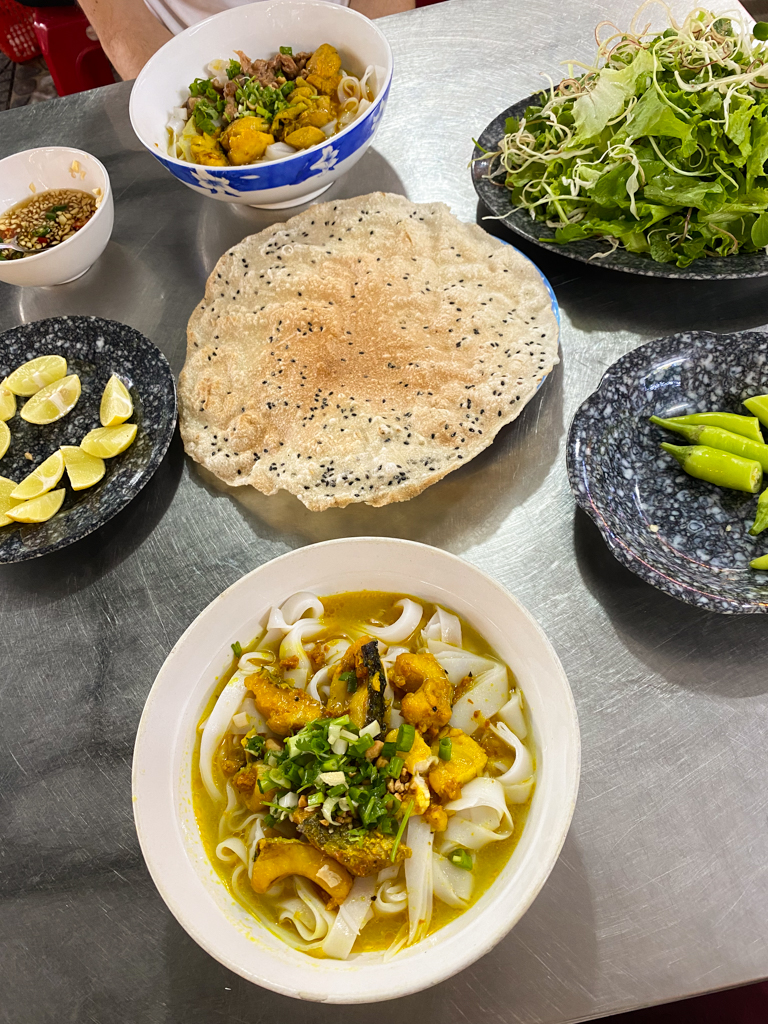
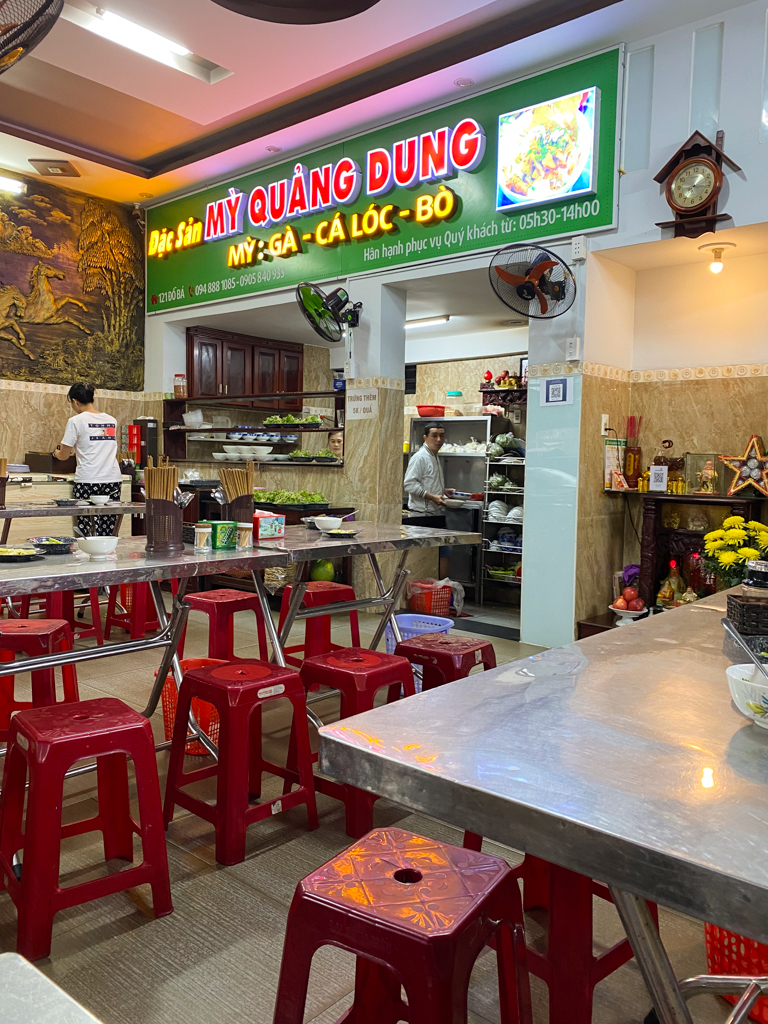
After breakfast, we went to a coffee shop across the street with the most adorable dog visitor.


At this point, it started to rain, but determined to not let the weather ruin our plans, we ordered a Grab to make our way to the main event: the Marble Mountains. The Marble Mountains is a group of five limestone peaks located seven kilometres from downtown Da Nang. The five karsts (called Ngu Hanh Son in Vietnamese) are named after the five elements: Kim (metal), Thuỷ (water), Mộc (wood), Hoả (fire) and Thổ (earth). It’s home to a network of caves, tunnels, towers, and pagodas built by Mahayana Buddhists and the Nguyen Dynasty Kings.
Thuy Son (Water Mountain) is the largest and most famous of the five mountains, so we only visited this one. It does have the vast majority of interesting things to see. The other mountains appear to be much smaller.
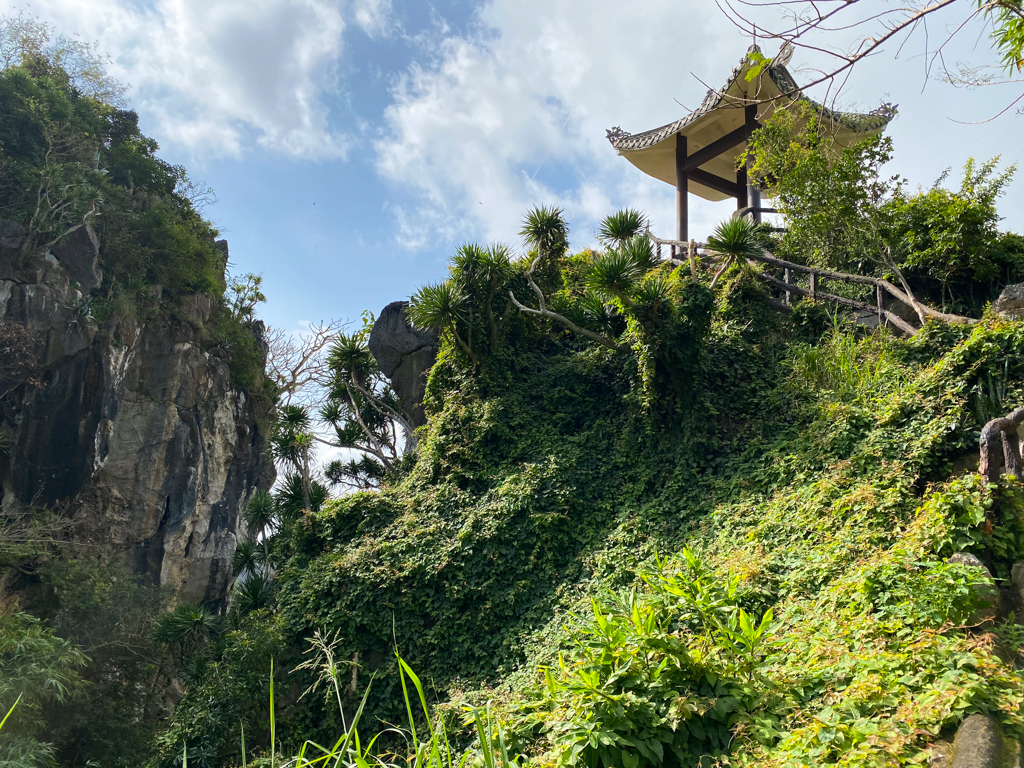 We started at the foot of the mountain with Am Phu Cave. Am Phu means “the Hell” in Vietnamese. Once we reached the first chamber we saw a staircase to the left, leading to the highest accessible point of the cave. Locals call it “the Heaven”. That’s why visitors will see Buddha statues, birds, and clouds that remind them of heaven. The stairs are extremely steep, especially as you get closer to the top.
We started at the foot of the mountain with Am Phu Cave. Am Phu means “the Hell” in Vietnamese. Once we reached the first chamber we saw a staircase to the left, leading to the highest accessible point of the cave. Locals call it “the Heaven”. That’s why visitors will see Buddha statues, birds, and clouds that remind them of heaven. The stairs are extremely steep, especially as you get closer to the top.
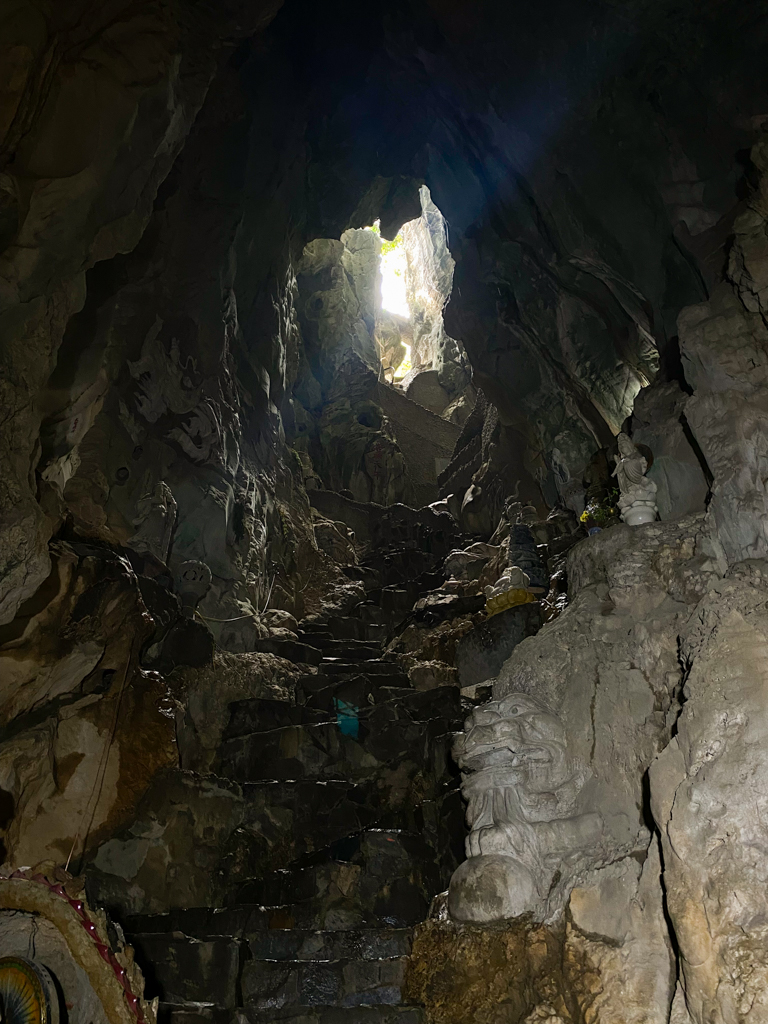

The first chamber leads into the main chamber, which is spectacular, truly like a cathedral.


To the right of the main chamber is the court of the hell kings, ten kings that judge the dead. There’s also the magical mirror. To the left is the court of judgment and the balance of judgment, where individuals are weighed based on their actions in life. The kings determine whether a person should go to hell, or heaven or continue to live on Earth.


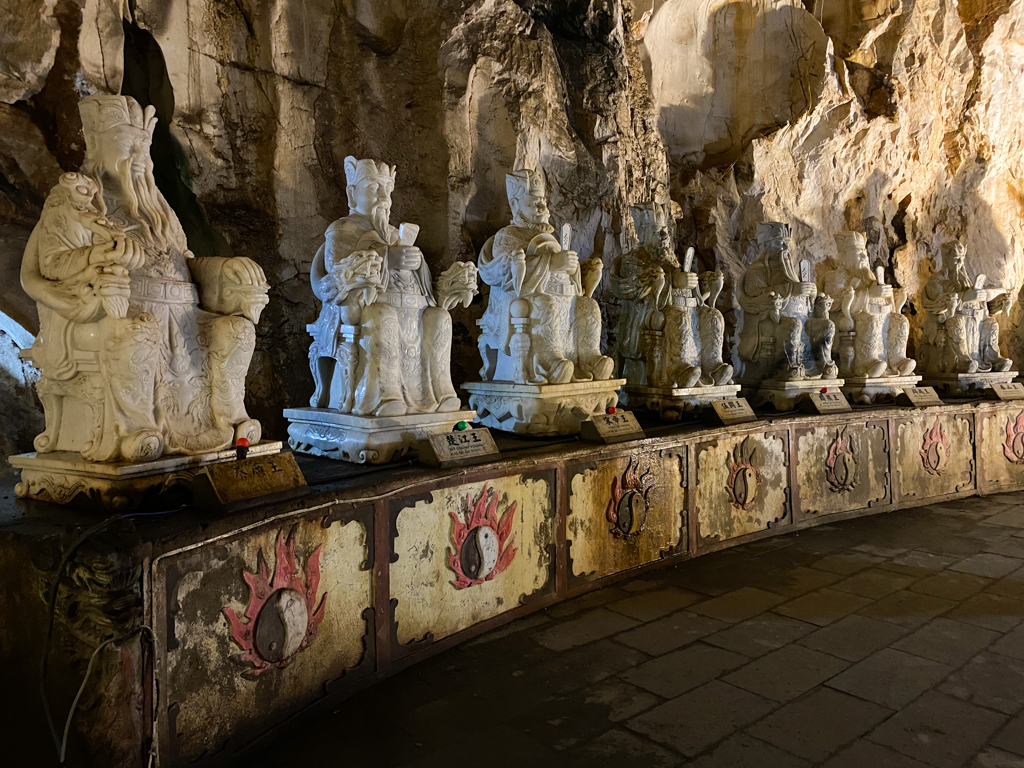
Before entering the next chamber there is the hell gate. Beyond the hell is a chamber with the throne of Ksitigarbha Bodhisattva, often referred to as the Bodhisattva (an individual on the path to becoming a Buddha) of the Hell beings.
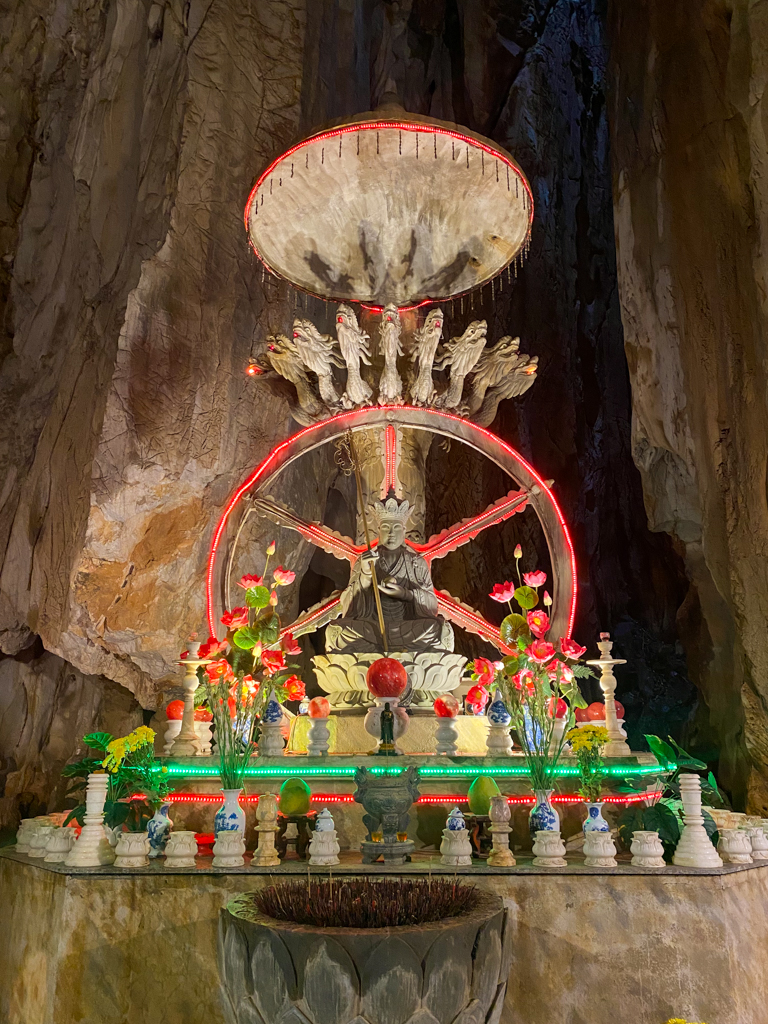 Once we finished exploring the cave, it was time to go up the mountain. There are two options: paying for an elevator ride up or climbing 165 steps. We opted for the former because we had read that you have to climb many steps throughout the sites anyway, so there’s no need to have a warm-up of 165 steps.
Once we finished exploring the cave, it was time to go up the mountain. There are two options: paying for an elevator ride up or climbing 165 steps. We opted for the former because we had read that you have to climb many steps throughout the sites anyway, so there’s no need to have a warm-up of 165 steps.
The first site we came across on top of the mountain was Xa Loi Pagoda, a beautiful stone tower that overlooks the coast. The tower is a recent addition as it was built in 1997, but it fits into the landscape so well that it feels like it has always been there.
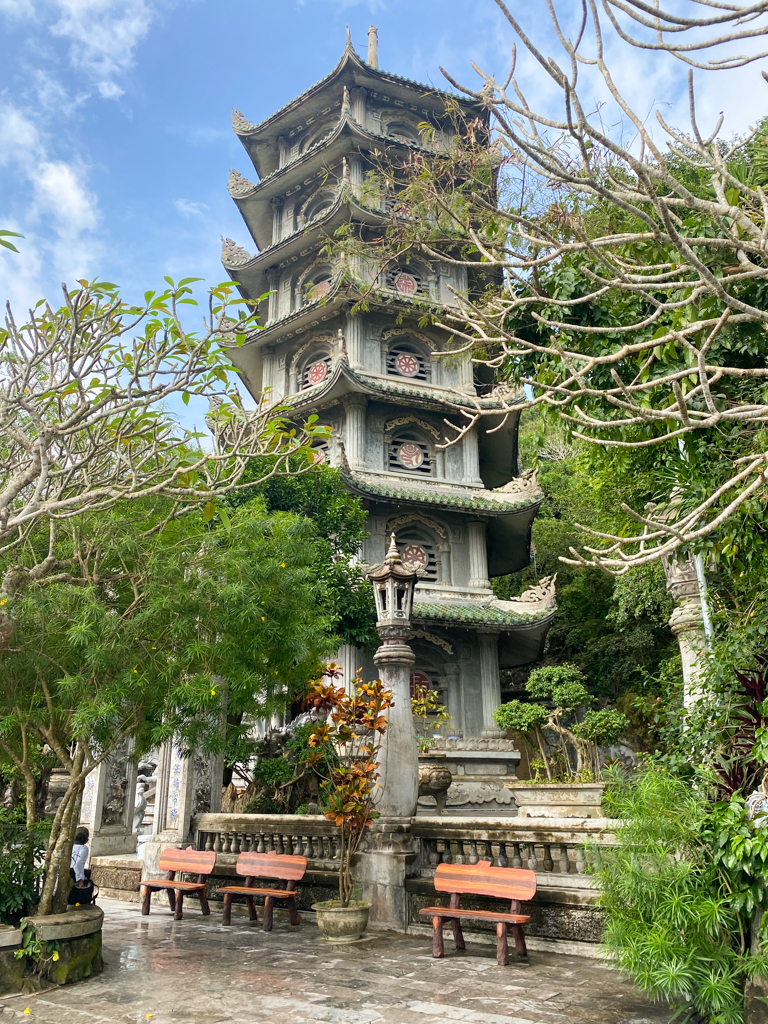 I already mentioned the Linh Ong Pagoda on Monkey Mountain, but I also mentioned that there are actually three places called Linh Ong Pagoda. One is here in the Marble Mountains. This Linh Ong Pagoda was established in the 18th century but then was reinforced with bricks and tiles in 1825. A typhoon in 1901 damaged the pagoda, but it was renovated in 1992. It’s a beautiful structure, with these colourful tiled dragons.
I already mentioned the Linh Ong Pagoda on Monkey Mountain, but I also mentioned that there are actually three places called Linh Ong Pagoda. One is here in the Marble Mountains. This Linh Ong Pagoda was established in the 18th century but then was reinforced with bricks and tiles in 1825. A typhoon in 1901 damaged the pagoda, but it was renovated in 1992. It’s a beautiful structure, with these colourful tiled dragons.

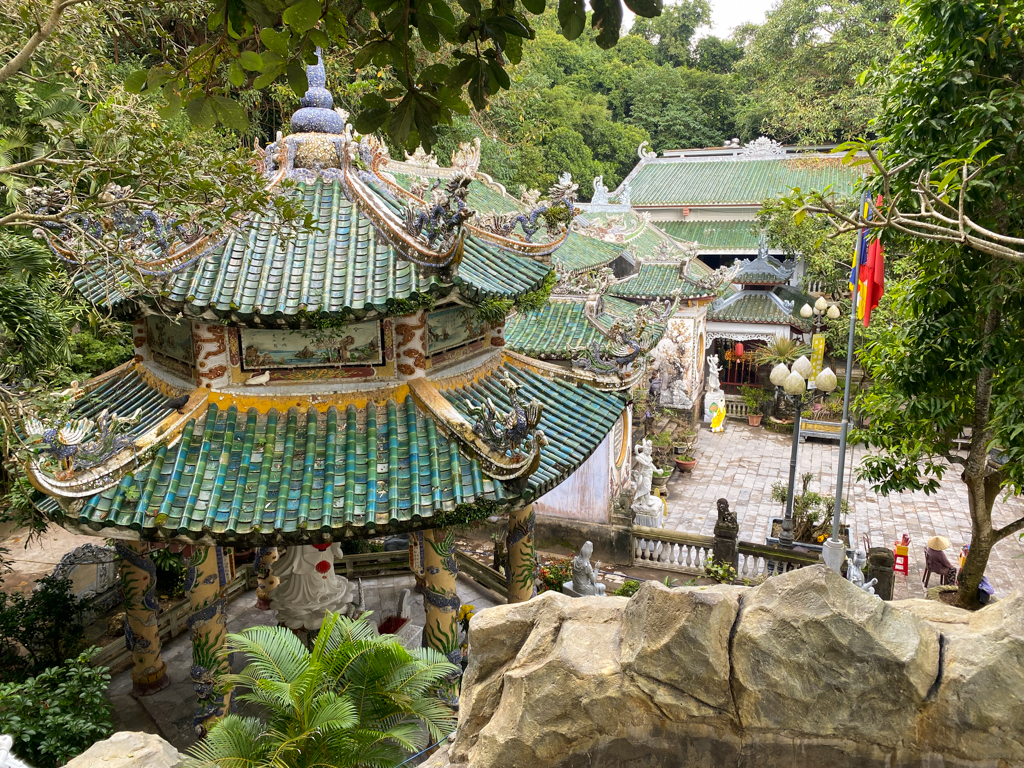 Behind the pagoda, a path heads through two tunnels to caverns that contain several Buddhas and Cham carvings. A flight of steps also leads up to another cave, partially open to the sky, with two seated Buddhas in it.
Behind the pagoda, a path heads through two tunnels to caverns that contain several Buddhas and Cham carvings. A flight of steps also leads up to another cave, partially open to the sky, with two seated Buddhas in it.
Back onto the main path, we went through Hoa Nghiem Cave to get to Huyen Khong Cave. The latter is a cathedral cave lit by an opening to the sky. The entrance to this spectacular chamber is guarded by two administrative mandarins (to the left) and two military mandarins (to the right).

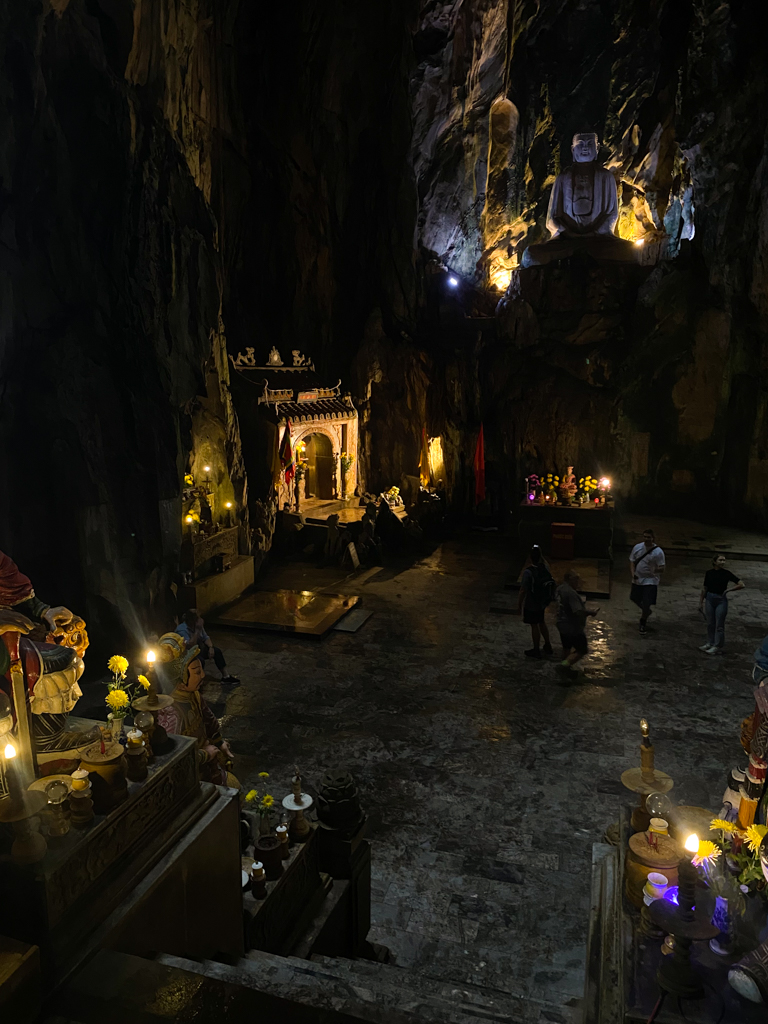
We then visited Tam Thai Pagoda, an ancient pagoda built during the Le Dynasty in the 17th century. Its entrance features a 3-door gate, with the middle gate reserved for monks and the left and right gates for men and women, as per Buddhist tradition. I started to recognise the colourful tiles dragons lining the roofs which we had just seen at Linh Ong Pagoda, and we would continue to see them throughout Central Vietnam.
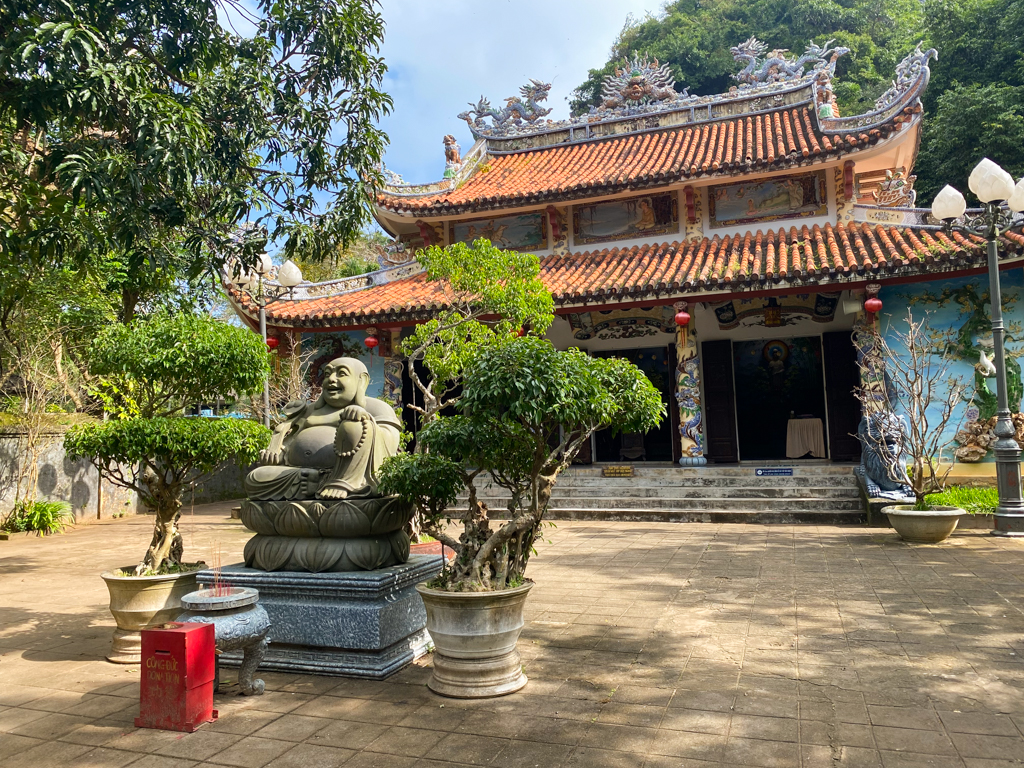 We visited a few more pagodas spotted around the complex and then made our way back to the elevator to head back to Da Nang.
We visited a few more pagodas spotted around the complex and then made our way back to the elevator to head back to Da Nang.
The Water Mountain is truly spectacular and a place I definitely recommend anyone visit. It was one of our favourite sites of the whole trip. There’s something magical and almost mystical about the way the caves and structures interact with the mountain. While it was starting to get really hot already, I nevertheless felt refreshed and rejuvenated.
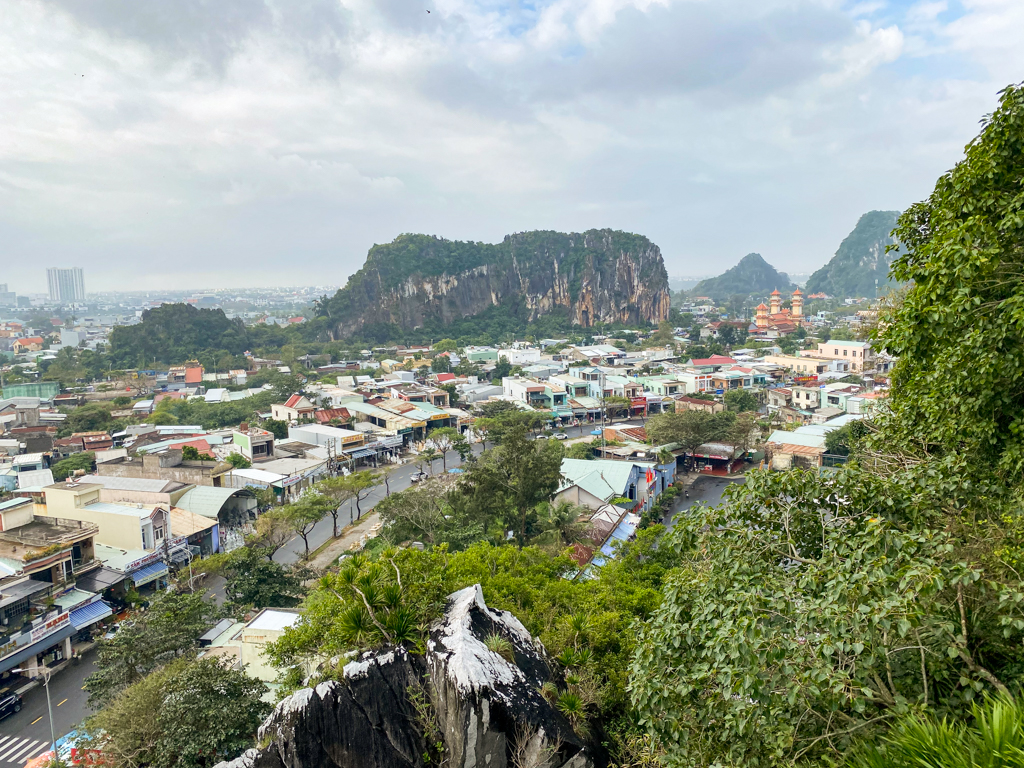 For lunch we took a Grab to a famous institution back in downtown Da Nang, Bánh Xèo Bà Dưỡng. Bánh xèo is a crispy, stuffed rice pancake. The pancake is made from rice flour, water, and turmeric powder. The pancake is used as a wrap for fillings, like pork, prawns, and bean sprouts. It’s also common to add leafy greens, like lettuces or perilla leaves, and herbs like Thai basil. You’ll also often see cucumbers and pickled vegetables, usually carrots and radishes. One of the most important components of the dish is the dipping sauce. In most places, the dipping sauce is nước chấm (sweet and sour garlic fish sauce). However, Da Nang’s bánh xèo is served with a unique sauce made of pork liver, hoisin sauce, and garlic, rather than the traditional nước chấm.
For lunch we took a Grab to a famous institution back in downtown Da Nang, Bánh Xèo Bà Dưỡng. Bánh xèo is a crispy, stuffed rice pancake. The pancake is made from rice flour, water, and turmeric powder. The pancake is used as a wrap for fillings, like pork, prawns, and bean sprouts. It’s also common to add leafy greens, like lettuces or perilla leaves, and herbs like Thai basil. You’ll also often see cucumbers and pickled vegetables, usually carrots and radishes. One of the most important components of the dish is the dipping sauce. In most places, the dipping sauce is nước chấm (sweet and sour garlic fish sauce). However, Da Nang’s bánh xèo is served with a unique sauce made of pork liver, hoisin sauce, and garlic, rather than the traditional nước chấm.
At Bánh Xèo Bà Dưỡng we ordered their bánh xèo, which is filled with prawns and bean sprouts and served with Da Nang’s special sauce. We also ordered nem lụi, which is ground pork that’s grilled on a lemongrass skewer and served with a sweet and sour peanut sesame sauce. Both dishes are served with vegetables, herbs, and rice paper which is used to make a spring roll with the filling (the bánh xèo or the nem lụi) and accompaniments. It’s a lot of fun and Victor often cites this place as one of his favourite eats in all of Vietnam.


We stopped for a coffee at 3lacafé (or 3lacafé & more. as it’s called on Google Maps), a beautiful coffee shop with two floors. We were in the company of university students, working away. Once we finished we went back to our accommodation to pick up our luggage and take another Grab onto our next adventure: the nearby village of Hội An. Stay tuned next time to read all about it!
I truly loved the excitement of Da Nang. What do you think of this modern city?

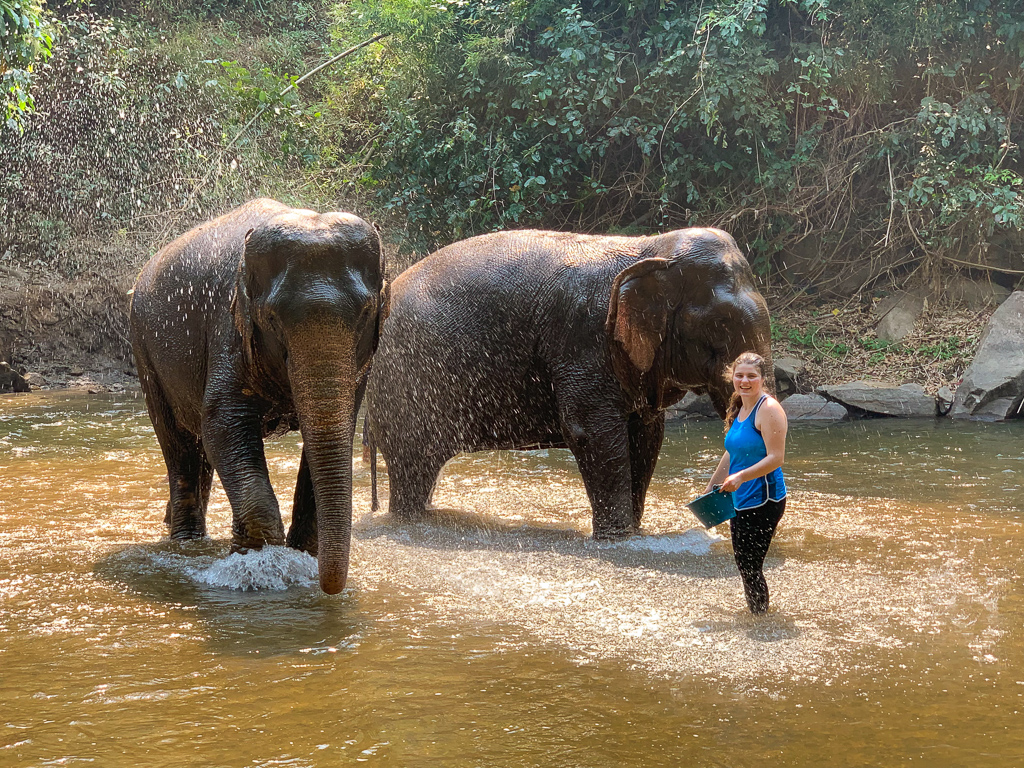

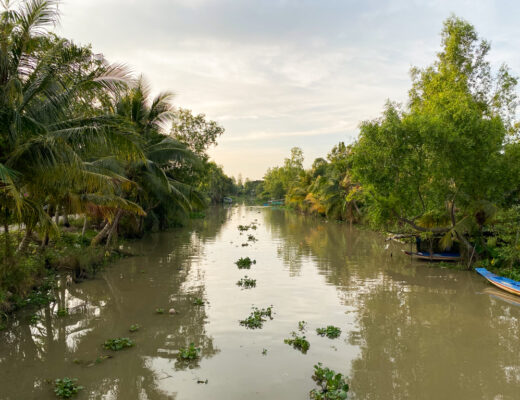
No Comments